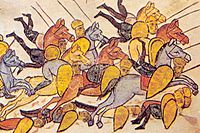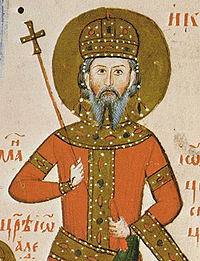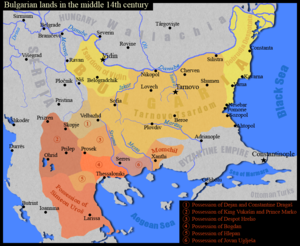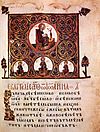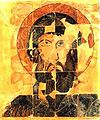- Bulgarian–Ottoman Wars
-
Bulgarian-Ottoman Wars 
Clockwise from right: Emperor Ivan Alexander, the remains of the Shumen fortress, Sultan Bayazid IDate c.1340 - 1396 (1422) Location Balkan Peninsula Result Decisive Ottoman victory Territorial
changesThe Bulgarian Empire is conquered by the Ottoman Empire Belligerents Bulgarian Empire†
 Ottoman Empire
Ottoman EmpireCommanders and leaders Ivan Alexander
Ivan Shishman
Ivan Sratsimir
Dobrotitsa
MomchilMurad I
Bayezid I
Lala Shahin PashaStrength Unknown Unknown Casualties and losses Heavy Heavy Bulgarian-Ottoman WarsThe Bulgarian-Ottoman wars were fought between the disintegrating Bulgarian Empire and the new emerging Turkic power, the Ottoman Turks in the second half the 14th century and the beginning of the 15th century. The war ended with the collapse of the once powerful Bulgarian Empire in 1422. The Bulgarians reestablished their state after almost five centuries of Ottoman domination in 1878. As a result of the wars the Ottoman Empire greatly expanded its territory on the Balkan peninsula, stretching from the river Danube to the Aegean Sea. In Bulgaria that period is usually described as the struggle of the Bulgarian people against the Ottoman army.
Contents
The situation in the Balkans on the eve of the Ottoman invasion
From the 13th century, in the two main Balkan powers Byzantium and Bulgaria which used to be strongly centralized began the process of decentralization as the local feudal lords grew stronger and more independent from the Emperors in Constantinople and Tarnovo which weakened their military and economic power. These processes grew even stronger in the 14th century with numerous nobles being only nominally submitted to the central government. In Bulgaria the strong house of Shishman ruled over the Vidin Province to the west, while to the east the noble Balik was trying to get more independence from Tarnovo.
While the two Empires were facing enormous internal difficulties, the Serbs took the favourable opportunity to expand their kingdom. During the civil war in Byzantium in 1320s and 1330s, they managed to conquer most of the Bulgarian populated Macedonia, which was then held by the Byzantines. In 1330 the Serbs defeated the Bulgarian Emperor Michail Shishman at Velbazhd and emerged as the most powerful state in the region and in 1346 their king Stefan Uroš IV Dušan received Imperial title with the blessing of the Bulgarian Emperor Ivan Alexander. However, after his death in 1355, his large Empire disintegrated into numerous completely independent states. In the same time in Bulgaria Ivan Alexander gave the rule of Vidin to his first son, Ivan Sratsimir in 1356 and in Dobrudzha ruled despot Dobrotitsa who was nominally subjected to him. In 1341-1347 the Byzantine Empire was shaken in a bloody civil war between John V Palaiologos and John VI Kantakouzenos.
Towards the middle of the century the Balkans were tens of small states constantly in war or plotting against each other with not a single strong country with a large army. In addition to the mainly Orthodox countries such as Bulgaria, Byzantium and Serbia, there were a number of Catholic possessions to the west and south held by Venice, Genova and the Kingdom of Hungary as well as Kingdom of Bosnia whose Bosnian Church (closely related to the Bogomils) was considered heretic by both Orthodox and Catholics. The religious diversity was another source for the constant tensions in the region.
Military actions during the reign of Ivan Alexander
During the civil war in Byzantium both Palaiologos and Kantakouzenos were trying to find external allies and used foreign mercenaries. The Bulgarian Emperor supported the first opponent whose stronghold was Constantinople. John Kantakouzenos on the other hand regularly hired Ottoman Turk mercenaries from Asia Minor whose bands soon became a common thing in Thrace. Despite being their allies, the Byzantines could not fully control them and they brought the region into ruins and launched regular attacks on Bulgarian territory to plunder the villages.
In 1344 the independent Bulgarian ruler of the Rhodope and Aegean regions Momchil whose army grew to 2,000 men[1] took an important role in the Byzantine civil war. At first he supported John Kantakouzenos but from the spring of 1344 he reneged on him due to the atrocities of his Ottoman allies.[2][3] In June he defeated the Ottoman fleet near the Portogalos bay.[4] At night he sent boats which burned the anchored ships of the enemy. Soon after this success he defeated the army of Kantakouzenos at Mosinopol.[4]
He was among the first local rulers who realized the threat of the Ottomans. Momchil pleaded both the Emperors of Bulgaria and Byzantium for help but received none. Even though he continued the resistance in the eastern part of the Rhodope mountains. In May 1345 the Turks led by Uner beg marched from Asia Minor to the Balkan Peninsula and made a devastating raid on Bulgarian territory driving away many people and cattle.[5] Soon after that, on 7 July 1345 the Bulgarian forces were defeated in the battle of Peritor[6] near Momchil's seat Xanthi by superior Ottoman forces under Uner beg and Momchil perished in the battle.[7]
During the civil wars in the Byzantine Empire Ivan Alexander regained the control of several towns in Thrace and the Rhodopes but his frequent interference in the internal affairs of Byzantium hampered any closer relations between the two counties although they were in peace from 1332. In 1352 new Turkish forces invaded Bulgaria, devastated its southern areas and returned with huge spoils.[8] Aitos, Diampol and Plovdiv suffered most. In the same year the Ottomans seized their first fortress on the Balkans, Tsimpe in the Galipoli peninsula and soon set firm foot in Europe.[9] Between 1352 and 1354 they ravaged the lands around Yambol and Plovdiv as well as the lower reaches of the Maritsa and Tundzha rivers.[10]
In 1355 the Ottomans launched a campaign in the direction of Sofia and were engaged by a Bulgarian army under Ivan Alexander's eldest son and heir Michael Asen in the vicinity of the city, probably around Ihtiman. In the following battle the Turks prevailed. Both sides suffered heavy casualties including the young Micheal Asen but eventually the Turks did not reach Sofia.[11]
The unexecuted alliance
The defeat raised serious alert not only in Tarnovo but also in Constantinople and John Kantakouzenos was forced to abdicate. Thus one of the main perpetrators of the Ottoman invasion was removed from the political scene. Faced with that threat, Bulgaria and Byzantium made an attempt for rapprochement. In 1355 the daughter of the Bulgarian Emperor, Keratsa married the son of the new Byzantine Emperor John V, the infant Andrinokos.[12] The new relations between the houses of Tarnovo and Constantinople should have been harmful to the invaders but despite the anticipation the agreement did not pay off.
In that period the Bulgarian and Byzantine Empires were once again the major political power on the peninsula and the only countries which were able to stop the penetration of the Ottoman Turks and seriously resist them. After the death of Stefan Dushan on 20 December 1355 Serbia lost its political influence and his large but ethnically diverse country split into many states.[13] Between 1354 and 1364 the Turks became masters of Thrace and a number of important castles and towns fell under their attacks including Plovdiv and Stara Zagora.[14] From the end of the 1350s some Ottoman companies even reached the surroundings of the capital and the Emperor took precautions to repair the decayed walls of the city.[15] It is known from the records of the Ottoman chronicler Seadeddin and other chronicles that the Ottoman advance between 1359 and 1364 involved enormous destruction and total depopulation of certain areas. Many cities were devastated (Plovdiv, Stara Zagora, Sliven) while others such as Venets and Sotirgrad disappeared forever.[16] The devastation was accompanied by mass slaughter or deportation of population to Asia Minor.[17]
Not only was there a total lack of coordination between the two Empires but they also quarreled for the Black Sea ports of Nessebar and Pomorie which the Bulgarians successfully defended in 1364. The war brought nothing to the two parties involved but completely ruined the relation between the two states.[18]
The last years of Ivan Alexander
Apart from the threat from the south, Bulgaria had other problems: in 1365 the Hungarian King Louis I invaded north-western Bulgaria, seized the large fortress Vidin and captured the eldest surviving son of the Emperor, Ivan Sratsimir.[19] In futile attempts to reconquer Vidin Ivan Alexander even used Ottoman mercenaries.[20] However, in the summer of 1369 the Bulgarian Emperor restored his authorities over the Vidin Province with the help of the Wallachian voivoda Vladislav I[21] but that proved to be his last success - on 17 February 1371 he died.
After Ivan Alexander's death the Bulgarian lands were divided in several independent states. Most of the area with centre Tarnovo came under his third son Ivan Shishman, in Vidin ruled his eldest son Ivan Sratsimir, despot Dobrotitsa held Dodrudzha and Macedonia was divided in several feudal feudal states ruled by Serb nobles.
The battle of Chernomen and consequences
Main article: battle of MaritsaIn 1371 two feudal lords in Macedonia organised a campaign against the Turks. The Serbian king of Prilep Vukashin and the despot of Ser Uglesha who were brothers gathered a large Christian army to stop the Muslim invaders. Uglesha whose lands bordered with the Ottomans to the east had realized that if they were not stopped soon they would conquer the whole region and called rest of Serbia and some Bulgars for help but both states could not send troops. The army of the two brothers who were themselves Serbs but ruled over mixed Serbian-Greek-Bulgarian-populated lands set of to the east with 70,000 (according to other sources 20,000) Serbian-Bulgarian army. When they reached the village of Chernomen in the lower course of the Maritsa river their camp was attacked at night on 26 September by a considerably smaller enemy force under Lala Shahin Pasha and allies were routed. Valkashin and Uglesha along with most of the army perished.[22]
Immediately after the battle the armies of Murad I headed towards Bulgaria and forced the young Emperor Ivan Shishman to pull back to the north of the Stara planina and overran northern Thrace. Many castles fell after prolonged sieges. The town of Diampol fought against the hordes under Timurtash for months but after the shortage of food the population was forced to surrender.[23] During the fights in the southern slopes of Stara Planina one of Ivan Shishman's voivods, Shishkin perished. Soon the Ottomans seized the Rhodopes, Kostenets, Ihtiman and Samokov, nearly reaching the Sofia Valley. After a bloody siege they captured Bitola in the south-western Bulgarian lands.[23] In 1373 Ivan Shishman had to negotiate for peace. The peace treaty was humiliating: the Bulgarian ruler became an Ottoman vassal and had to give his sister Kera Tamara for Murad's wife. As a compensation, the Ottomans returned some of the conquered areas including Ihtiman and Samokov.[24]
Between 1371 and 1373 the Ottomans emerged as a considerable power which every Balkan ruler had to take into an account. They ruled over the whole of Thrace and seized the lands of Uglesha in western Macedonia. The son of Valkashin Marko and Ivan Shishman became their vassals.
The fall of the Rhodopes
During the same period (1371–1373) the invaders took control of the Rhodopes, a mountain studded with strong and well-guarded fortresses. The Turks rushed in from the northern slopes of the mountains.[25] After a fierce resistance fell the Rakovitsa fortress (now in ruins). It was besieged by the forces of Daud pasha and the defense was led by the voivoda Kurt. After futile attempts to capture the castle with force the Turk agreed to negotiations and the Bulgarians surrendered and kept their property.[19]
The Ottomans fought bloody battles to take over one of the major castles in the Rhodopes, Tsepina. For 9 months its population repulsed the enemy attacks but eventually surrendered in return for their lives and property[26] after the Turks under Daud pasha cut off the water-conduit.[27] In the same manner was taken Stanimaka (Asenovgrad).[28] After a bitter siege fell the fortress Batkun on the northern slopes of the Rhodopes. Its commander Georgi was killed along his men in the final assault.[29]
The Ottomans faced a stubborn resistance in the interior of the Rhodope massif. The central areas were invaded by two armies commanded by Dzhedit pasha and Ibrahim pasha. Dzhedit pasha advanced on the road Stanimaka - Bachkovo Monastery along the valley of the Chepelarska river, and Ibrahim pasha set off from Plovdiv via Parvenets and then through the valley of the Vacha River. Fighting occurred at the fortified settlements or locations Zarenitsa, Zagrad, Gradishte, Chiltepe and Karakulas (location along the valley of the Vacha), Imaretdere and Momina Voda (heights close to Ardino) and others. Especially fierce was the engagement at Momina Voda where one of the prominent Ottoman leaders Sarǎ Baba was killed. A bloody battle also occurred at Karakulas where another Ottoman chief - Enihan Baba perished.
Fall of Sofia
While Ivan Shishman was desperately trying to resist against the strong Ottoman pressure, his brother Ivan Sratsimir not only withheld reinforcements or help but tried to make use of the difficulties which his brother faced to expand his domains over certain areas of the Tarnovo Tsardom. As Shishman's attention was pointed to the south, Ivan Sratsimir took control of the important city of Sofia[30] which was disputed between the two brothers. However by 1373 the city was again in the Tarnovo Tsardom and it is possible that there might have been armed conflict between the two Bulgarian states.[31] Despot Dobrotitsa also did not give any support to the Emperor in Tarnovo. He was in conflict with Genova and was involved in the internal affairs of the Trapezund Empire trying to put on its throne his son-in-law.[32]
After the temporary hush which followed after 1373, in 1380 the Ottomans again started hostilities. With a large army Sultan Murad headed towards the south-western regions of the Tarnovo Tsardom which main objective to seize its center Sofia. After a bloody clashes in the Zlatitsa valley[33] the Turks moved on to Sofia and besieged it. The city which was commanded by ban Yanuka repulsed all the attacks of the superior Ottoman forces under Lala Shahin. The later could not continue the siege and was forced to pull back to Odrin where he reported his failure to the Sultan. While he was absent the Turks managed to infiltrate Sofia and one Muslim Bulgarian captured ban Yanuke while hunting and sent him to Lala Shahin who was in Plovdiv at that time. From there the Bulgarian commander was sent back to Sofia and when the defenders saw their captured leader they surrendered the city to the Ottomans (1382).[34]
The Ottomans installed a strong garrison and brought Muslim settlers from Asia Minor.[35] On the following year fell Serres[36] The new Ottoman success did not bring together Ivan Shishman and Ivan Sratsimir. Between 1384 and 1386 waged a war between Bulgaria and Wallachia, the Vlachs seized several settlements along the Danube but were later defeated and their voivoda Dan I was killed.[37] Ivan Sratsimir took part in the actions as an ally of the Vlachs[38] which proved the total lack of coordination between the Bulgarian states and deepened the mistrust between the two brothers.
After they secured the possession of the area around Sofia, the Ottomans continued their march to the north-west. The main objective of Murad was to break the ties between Bulgaria and Serbia because despite Ivan Shishman was his vassal, Murad did not trust him and knew that the Bulgarian ruler was waiting for an appropriate opportunity to renege. In 1386 the Turks seized Pirot and Niš after bitter fights killing and enslaving many Bulgarians.[39]
The campaign of 1388
The advance of the Ottomans in the central parts of the Balkan peninsula caused serious anxiety not only for Ivan Shishman but also in Serbia and Bosnia. The Serbian Prince Lazar and the Bosnian King Tvardko organized an anti-Ottoman coalition and the Bulgarian Emperor joined them but was unable to send troops. In 1387 the united forces of Bosnians and Serbs defeated the Turk in the battle of Plocnik.
However, while the Christian states did not make any attampt to use the victory, the Turks' reaction was swift. In 1388 a 30,000 strong army commanded by Ali Pasha passed through the eastern Balkan mountains and struck deep into Bulgaria's north. The Bulgarians were completely surprised and the invaders seized Ovech, Shumen, Madara and other towns.[40] Due to the surprise campaign at first the towns and the castles were unable to organize proper defence but after the initial shock the Bulgarians took precautions. When the army of Ali Pasha besieged Varna, the defenders stiffly resisted and the Turks were forced to abandon the siege and march northwards.[41]
In Tutrakan the citizens allowed the Turks to install a small garrison but then they killed the Turkish soldiers and prepared for siege. Ali Pasha immediately burned the surrounding fields and soon the starving town had to surrender.[42] After this success they advanced to the west towards Nikopol, one of the strongest Bulgarian fortresses along the Danube. The defence was organized by Ivan Shishman who was currently in the town. Although the Ottomans had nearly 30,000 men they could not take it and Ali Pasha had to seek reinforcements from Murad himself. According to Seadeddin the Sultan marched to Nikopol with an enormous army firmly decided to seize the town at all costs. When Ivan Shishman faced the new enemy he sought a truce. Murad agreed and the Bulgarians saved Nikopol but were forced to cede another key Danubian fortress, Silistra. However, when Ali Pasha reached Silistra, the Bulgarians refused to surrender the town. Murad besieged Nikopol for a second time and this time Ivan Shishman agreed to the Ottoman conditions and a Turkish garrison was installed in Silistra.
As a result of the campaign the Turks took most of eastern Bulgaria including several key towns. Now the authority of Ivan Shishman reduced to the lands to the west of the capital Tarnovo and several castles along the Danube. To the east the Bulgarians kept Varna and the capital of the Principality of Karvuna, Kaliakra. Probably at that time Ivan Sratsimir became an Ottoman vassal.[43]
References
- Васил Н. Златарски, История на българската държава през средните векове, Част I, II изд., Наука и изкуство, София 1970.
- Атанас Пейчев и колектив, 1300 години на стража, Военно издателство, София 1984.
- Йордан Андреев, Милчо Лалков, Българските ханове и царе, Велико Търново, 1996.
Footnotes
- ^ Nicephorus Gregoras. Byzantina historia. 2, p.702
- ^ Nicephorus Gregoras. Byzantina historia. 2, p.707
- ^ Ioannes Cantacuzenus. Historiarum... 2, p.16-19
- ^ a b Ioannes Cantacuzenus. Historiarum... 2, p.427
- ^ Ioannes Cantacuzenus. Historiarum... 2, p.530
- ^ Nicephorus Gregoras. Byzantina historia. 2, p.729
- ^ Lemerle, P. L'emirat d'Aydin..., p.210, 217
- ^ Ioannes Cantacuzenus. Historiarum... 3, p.250
- ^ Ioannes Cantacuzenus. Historiarum... 3, p.278
- ^ Ioannes Cantacuzenus. Historiarum... 3, p.279
- ^ Дуйчев, Ив. Из старата българска книжнина. 2, с.267
- ^ Nicephorus Gregoras. Byzantina historia. 3, p.557
- ^ Jиречек, К. Историjа срба. 1, с.305
- ^ Ников, П. Турското завладяване на България и съдбата на последните Шишмановци-ИИД, 7-8, 1928, с.48
- ^ Demetrius Cydones. Ad Romaeos deliberativa. - PGr, 104, p.981
- ^ Angelov, D. Certains aspects de la conquete des peuples balkaniques par des turks - BSI, 1956, 162, p. 237
- ^ Seadeddin, Chronica dell' origine e progresse della casa ottomana. Vienna, 1649, p. 87
- ^ Ioannes Cantacuzenus. Historiarum... 3, p.362
- ^ a b Иречек, К. История на българите, С., 1929, с. 248
- ^ Ников, П. Турското завладяване на България и съдбата на последните Шишмановци-ИИД, 7-8, 1928, с.105-107
- ^ Иречек, К. История на българите, С., 1929, с. 244-245
- ^ Дуйчев, Ив. Българското средновековие. От Черномен до Косово поле, С., 1972, с.546
- ^ a b Seadeddin, Chronica dell' origine e progresse della casa ottomana. Vienna, 1649, p. 101
- ^ Синодник царя Борила, с. 89
- ^ Делчев, В. Миналото на Чепеларе. 1. С., 1928, с.15
- ^ Захариев, Ст. Цит. съч., с. 66
- ^ Шишков, Ст. Цит. съч., с. 64
- ^ Шишков, Ст. Цит. съч., с. 6
- ^ Захариев, Ст. Цит. съч., с. 74
- ^ Kuzev, Al. Die Besiehungen der Königs von Vidin, Ivan Sracimir zu den osmanischen Herrschern. EB, 1971, No. 3, p.121-124
- ^ Петров, П. Търговски връзки между България и Дубровник през XIV в. - ИБИД, 25, 1967, с.110
- ^ Мутавчиев, П. Добруджа в миналото, c. 44
- ^ Цветкова, Б. Героичната съпротива на българите срещу османските нашественици, ц. 39
- ^ Seadeddin, Chronica dell' origine e progresse della casa ottomana. Vienna, 1649, p. 122 sq
- ^ Laonicus Chalcocondylas. Historiarum demonstrationes. 1., p. 94
- ^ Ostrogorsky, G. La prise de Serres par les Turcs - Byz, 35, 1965, p. 302 sq
- ^ Istoria României. 2, p. 253
- ^ Иречек, К. История на българите, с. 262
- ^ Seadeddin, Chronica dell' origine e progresse della casa ottomana. Vienna, 1649, p. 124 sq
- ^ Seadeddin, Chronica dell' origine e progresse della casa ottomana. Vienna, 1649, p. 137 sq
- ^ Lennciavius. Historiae musulmane turcorum de monumentis ipsorum sxcerptae. Libri XIII, Frankfurt, 1501, p. 272
- ^ Lennciavius. Historiae musulmane turcorum de monumentis ipsorum sxcerptae. Libri XIII, Frankfurt, 1501, p. 274
- ^ Ников, П. Турското завладяване на България и съдбата на последните Шишмановци-ИИД, 7-8, 1928, с.98
Categories:- 14th-century conflicts
- Wars involving Bulgaria
- Wars involving the Ottoman Empire
Wikimedia Foundation. 2010.

